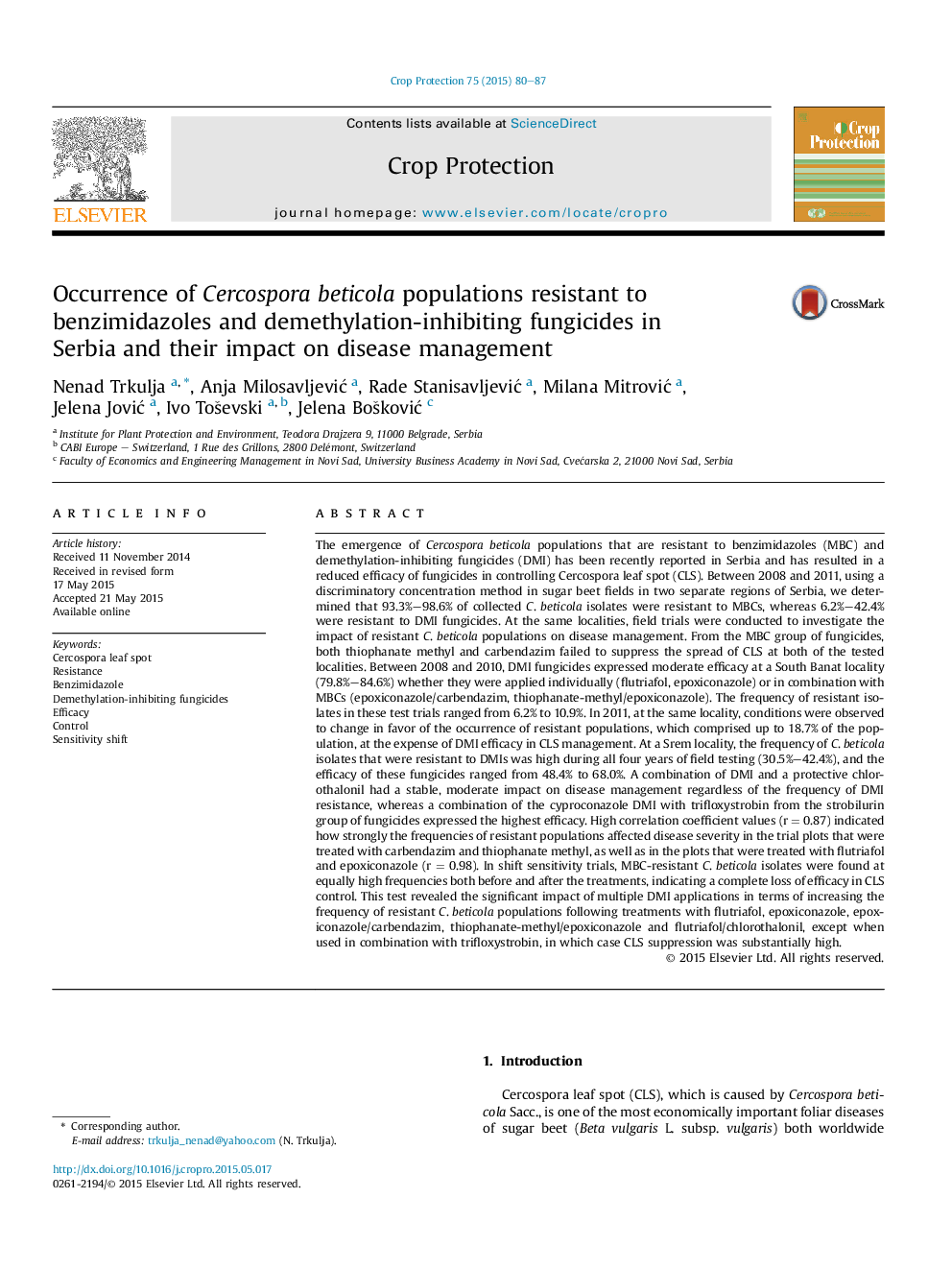| کد مقاله | کد نشریه | سال انتشار | مقاله انگلیسی | نسخه تمام متن |
|---|---|---|---|---|
| 6373491 | 1624312 | 2015 | 8 صفحه PDF | دانلود رایگان |
عنوان انگلیسی مقاله ISI
Occurrence of Cercospora beticola populations resistant to benzimidazoles and demethylation-inhibiting fungicides in Serbia and their impact on disease management
دانلود مقاله + سفارش ترجمه
دانلود مقاله ISI انگلیسی
رایگان برای ایرانیان
کلمات کلیدی
موضوعات مرتبط
علوم زیستی و بیوفناوری
علوم کشاورزی و بیولوژیک
علوم زراعت و اصلاح نباتات
پیش نمایش صفحه اول مقاله

چکیده انگلیسی
The emergence of Cercospora beticola populations that are resistant to benzimidazoles (MBC) and demethylation-inhibiting fungicides (DMI) has been recently reported in Serbia and has resulted in a reduced efficacy of fungicides in controlling Cercospora leaf spot (CLS). Between 2008 and 2011, using a discriminatory concentration method in sugar beet fields in two separate regions of Serbia, we determined that 93.3%-98.6% of collected C. beticola isolates were resistant to MBCs, whereas 6.2%-42.4% were resistant to DMI fungicides. At the same localities, field trials were conducted to investigate the impact of resistant C. beticola populations on disease management. From the MBC group of fungicides, both thiophanate methyl and carbendazim failed to suppress the spread of CLS at both of the tested localities. Between 2008 and 2010, DMI fungicides expressed moderate efficacy at a South Banat locality (79.8%-84.6%) whether they were applied individually (flutriafol, epoxiconazole) or in combination with MBCs (epoxiconazole/carbendazim, thiophanate-methyl/epoxiconazole). The frequency of resistant isolates in these test trials ranged from 6.2% to 10.9%. In 2011, at the same locality, conditions were observed to change in favor of the occurrence of resistant populations, which comprised up to 18.7% of the population, at the expense of DMI efficacy in CLS management. At a Srem locality, the frequency of C. beticola isolates that were resistant to DMIs was high during all four years of field testing (30.5%-42.4%), and the efficacy of these fungicides ranged from 48.4% to 68.0%. A combination of DMI and a protective chlorothalonil had a stable, moderate impact on disease management regardless of the frequency of DMI resistance, whereas a combination of the cyproconazole DMI with trifloxystrobin from the strobilurin group of fungicides expressed the highest efficacy. High correlation coefficient values (r = 0.87) indicated how strongly the frequencies of resistant populations affected disease severity in the trial plots that were treated with carbendazim and thiophanate methyl, as well as in the plots that were treated with flutriafol and epoxiconazole (r = 0.98). In shift sensitivity trials, MBC-resistant C. beticola isolates were found at equally high frequencies both before and after the treatments, indicating a complete loss of efficacy in CLS control. This test revealed the significant impact of multiple DMI applications in terms of increasing the frequency of resistant C. beticola populations following treatments with flutriafol, epoxiconazole, epoxiconazole/carbendazim, thiophanate-methyl/epoxiconazole and flutriafol/chlorothalonil, except when used in combination with trifloxystrobin, in which case CLS suppression was substantially high.
ناشر
Database: Elsevier - ScienceDirect (ساینس دایرکت)
Journal: Crop Protection - Volume 75, September 2015, Pages 80-87
Journal: Crop Protection - Volume 75, September 2015, Pages 80-87
نویسندگان
Nenad Trkulja, Anja MilosavljeviÄ, Rade StanisavljeviÄ, Milana MitroviÄ, Jelena JoviÄ, Ivo ToÅ¡evski, Jelena BoÅ¡koviÄ,